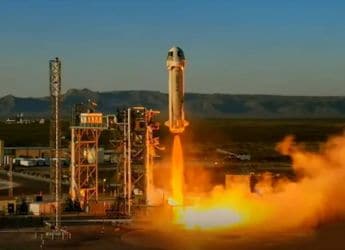- Home
- Science
- Science News
- Nasa 'Flying Saucer' Test Bedevilled for Second Time by Botched Parachute
Nasa 'Flying Saucer' Test Bedevilled for Second Time by Botched Parachute

A similar problem bedevilled the Low Density Supersonic Decelerator's (LDSD) debut run last year. The parachute was redesigned and reinforced for the second flight, but more work will be needed before the system is ready to land heavy loads on Mars.
"This is exactly why we do tests like this," Nasa engineer and LDSD mission commentator Dan Coatta said after the test. "When we're actually ready to send spacecraft to Mars, we know that they are going to work when that big mission is on the line."
The 100-foot diameter parachute - the largest ever tested - was the second part of a two-part supersonic braking system Nasa has been developing for about five years, at a cost of about $230 million.
Like last year, LDSD's doughnut-shaped extension ring inflated as expected, adding surface area to increase the amount of friction and slow the vehicle's descent through the atmosphere.
Monday's test began with a massive helium balloon lifting off from the U.S. Navy Pacific Missile Range Facility on Kauai, Hawaii, at 7:43 a.m. HST (1743 GMT.)
About three hours later, the balloon reached its targeted altitude of 120,000 feet (36,576 meters), at which point LDSD separated for its test run. A solid-rocket motor booted LDSD up to about 180,000 feet (54,864 meters) - roughly five times higher than where commercial passenger jets fly - and sent it soaring at nearly 3,000 mph (4,828 kph), or four times the speed of sound.
The speed and altitude were intended to simulate conditions that a spacecraft plunging through the thin atmosphere of Mars would experience.
Recovery ships were standing by in the Pacific to recover the spacecraft, parachute and other equipment.
© Thomson Reuters 2015
Get your daily dose of tech news, reviews, and insights, in under 80 characters on Gadgets 360 Turbo. Connect with fellow tech lovers on our Forum. Follow us on X, Facebook, WhatsApp, Threads and Google News for instant updates. Catch all the action on our YouTube channel.
Related Stories
- Samsung Galaxy Unpacked 2025
- ChatGPT
- Redmi Note 14 Pro+
- iPhone 16
- Apple Vision Pro
- Oneplus 12
- OnePlus Nord CE 3 Lite 5G
- iPhone 13
- Xiaomi 14 Pro
- Oppo Find N3
- Tecno Spark Go (2023)
- Realme V30
- Best Phones Under 25000
- Samsung Galaxy S24 Series
- Cryptocurrency
- iQoo 12
- Samsung Galaxy S24 Ultra
- Giottus
- Samsung Galaxy Z Flip 5
- Apple 'Scary Fast'
- Housefull 5
- GoPro Hero 12 Black Review
- Invincible Season 2
- JioGlass
- HD Ready TV
- Laptop Under 50000
- Smartwatch Under 10000
- Latest Mobile Phones
- Compare Phones
- Huawei Nova 15
- Huawei Nova 15 Pro
- Huawei Nova 15 Ultra
- OnePlus 15R
- Realme Narzo 90x 5G
- Realme Narzo 90 5G
- Vivo S50 Pro Mini
- Vivo S50
- Asus ProArt P16
- MacBook Pro 14-inch (M5, 2025)
- OnePlus Pad Go 2 (5G)
- Infinix Xpad Edge
- OnePlus Watch Lite
- Just Corseca Skywatch Pro
- Acerpure Nitro Z Series 100-inch QLED TV
- Samsung 43 Inch LED Ultra HD (4K) Smart TV (UA43UE81AFULXL)
- Asus ROG Ally
- Nintendo Switch Lite
- Haier 1.6 Ton 5 Star Inverter Split AC (HSU19G-MZAID5BN-INV)
- Haier 1.6 Ton 5 Star Inverter Split AC (HSU19G-MZAIM5BN-INV)
-
 Blue Origin Launches First Wheelchair User to Space and Back
Blue Origin Launches First Wheelchair User to Space and Back
-
 Planet-Eating Stars Offer a Glimpse Into Earth’s Fate as the Sun Nears Its Final Stages
Planet-Eating Stars Offer a Glimpse Into Earth’s Fate as the Sun Nears Its Final Stages
-
 New Ionic Liquid Breaks Stability Barrier for Perovskite Solar Cells
New Ionic Liquid Breaks Stability Barrier for Perovskite Solar Cells
-
 Yann LeCun Sets Up Advanced Machine Intelligence AI Startup After Announcing Departure From Meta
Yann LeCun Sets Up Advanced Machine Intelligence AI Startup After Announcing Departure From Meta






![[Partner Content] OPPO Find X9 Two Week Experience: Here's Why It Stands Out](https://www.gadgets360.com/static/mobile/images/spacer.png)





